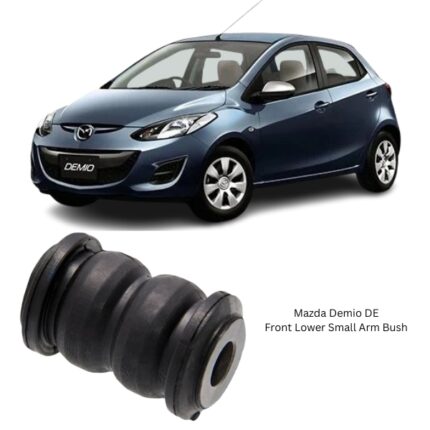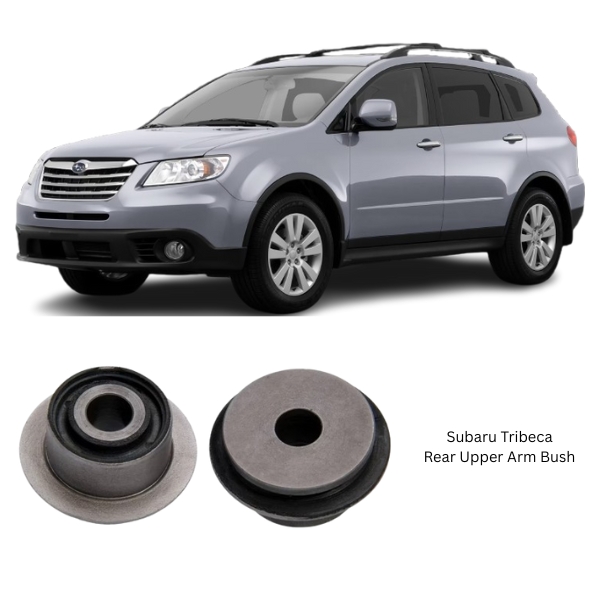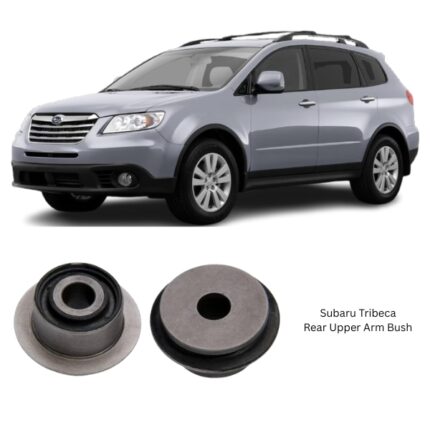Get Subaru Tribeca Rear Upper Arm Bush 20252-XA01A in Kenya
The Rear Upper Arm Bush is an essential suspension component found in the rear upper control arm of a vehicle. Though it appears as a simple cylindrical piece of rubber or polyurethane bonded to a metal sleeve, its role in maintaining vehicle handling, alignment, and ride quality is fundamental. The rear upper control arm, to which the bush is fitted, forms part of a complex network of suspension components designed to support vertical wheel movement while ensuring stability, predictability, and comfort during driving.
This detailed overview explores the function, design, materials, placement, failure signs, replacement practices, and importance of the Rear Upper Arm Bush, particularly in terms of how it contributes to a vehicle’s safety and performance.
1. Purpose and Function
The Rear Upper Arm Bush is designed to act as a flexible mounting point between the rear upper control arm and the vehicle’s chassis or rear subframe. Its primary functions include:
-
Vibration Isolation: Absorbs shocks and road vibrations, preventing them from being transmitted to the vehicle body and passenger cabin.
-
Noise Reduction: Minimizes the rattling and clunking sounds that could occur due to metal-on-metal contact.
-
Control Arm Articulation: Permits limited movement and rotation of the upper arm during suspension travel, maintaining wheel contact with the road.
-
Maintains Suspension Geometry: Helps preserve proper camber and toe angles, ensuring even tire wear and optimal handling.
-
Load Management: Transfers and dampens forces experienced during acceleration, braking, and cornering.
In summary, this bush ensures the upper control arm can pivot effectively while keeping the rear wheel aligned and supported under dynamic conditions.
2. Placement in the Suspension System
The Rear Upper Arm Bush is located at the inner end of the upper control arm—typically at the connection point where the arm bolts to the vehicle’s frame or subframe. The rear suspension system may have multiple control arms depending on the configuration (multi-link, double wishbone, or trailing arm setups). The upper control arm generally helps manage camber and support vertical and lateral loads, and the bushing ensures that this function is performed with minimal harshness or vibration.
In some designs, multiple bushings may be present in a single arm—one at each mounting point. The rear left and rear right upper arms both rely on their respective bushings for effective suspension articulation.
3. Construction and Materials
The Rear Upper Arm Bush is constructed to withstand mechanical stress, exposure to the elements, and long-term wear. Common materials include:
-
Rubber: Provides a balance of elasticity and damping, commonly used in standard passenger vehicles for comfort.
-
Polyurethane (PU): A tougher, more wear-resistant alternative to rubber. It offers improved responsiveness and durability, often chosen for performance or off-road use.
-
Metal Sleeves: Usually consists of an inner and outer sleeve made from steel or aluminum to provide structural integrity and allow secure bolting.
Some bushings may also be fluid-filled (hydraulic bushings), especially in high-end vehicles, to further dampen noise and vibrations.
4. Role in Suspension Dynamics
The Rear Upper Arm Bush significantly affects how the vehicle behaves, especially during cornering, braking, and load shifts. Here’s how it impacts suspension dynamics:
-
Ride Quality: Soft rubber bushings smooth out road imperfections and contribute to a comfortable, cushioned ride.
-
Handling Precision: Rigid or performance bushings (like polyurethane) reduce play in the suspension system, providing sharper handling and more accurate road feedback.
-
Tire Contact: Maintains proper suspension alignment, ensuring that tires remain flat and evenly engaged with the road surface.
-
Suspension Travel Control: Ensures that the upper control arm moves predictably within its intended path.
Even though the component is small, its failure can disrupt suspension balance, causing instability and rapid tire wear.
5. Common Signs of Wear or Failure
Over time, the Rear Upper Arm Bush may deteriorate due to continuous exposure to mechanical stress, temperature changes, road salts, oils, and general wear. Symptoms of a failing bushing include:
-
Clunking or Knocking Sounds: Especially when driving over bumps or during sudden acceleration and braking.
-
Poor Handling or Instability: The vehicle may sway excessively during cornering or feel loose and unresponsive.
-
Uneven or Rapid Tire Wear: A worn bushing can cause the upper control arm to shift, throwing off camber or toe settings.
-
Vibration or Noise from Rear Suspension: Especially when the bushing is severely cracked or missing chunks.
-
Misalignment: The rear wheels may become misaligned, affecting the vehicle’s tracking and straight-line stability.
Timely identification of these symptoms is essential to prevent further damage to the suspension system.
6. Maintenance and Replacement
While bushings are generally considered wear-and-tear items, proper maintenance and replacement practices can extend their life and preserve suspension performance.
Replacement Considerations:
-
Tool Requirements: Special bushing removal and installation tools or a hydraulic press may be required.
-
Accessing the Bushing: May involve removing the upper arm from the vehicle, which could also require detaching the wheel and some suspension components.
-
Alignment Needed: Any time a control arm or suspension component is removed or replaced, a wheel alignment is strongly recommended afterward.
-
Material Selection: Choose rubber for comfort and factory-like performance, or polyurethane for performance and durability.
-
Replace in Pairs: It’s best practice to replace bushings on both the left and right upper arms simultaneously to ensure even suspension behavior.
7. Variations Based on Vehicle Type
Depending on the suspension layout, different vehicles may have slight variations of the Rear Upper Arm Bush:
-
Standard Passenger Cars: Often use rubber bushings for comfort and economy.
-
SUVs and Trucks: May use heavier-duty bushings with reinforced sleeves or thicker rubber compounds for load-bearing durability.
-
Sports Cars: Often equipped with polyurethane or spherical bearings to maximize handling performance.
-
Luxury Vehicles: May incorporate hydraulic or dual-material bushings to reduce NVH (Noise, Vibration, Harshness) without sacrificing control.
Each type is engineered to suit the vehicle’s expected driving dynamics, weight distribution, and performance needs.
8. Engineering and Performance Insights
In terms of design and engineering, the Rear Upper Arm Bush must meet stringent criteria:
-
Fatigue Resistance: Must endure repeated cycles of tension, compression, and shear stress without cracking or deforming.
-
Thermal Stability: Operate effectively in both freezing cold and hot environments near exhaust systems or brake components.
-
Chemical Resistance: Withstand exposure to oils, greases, water, and road chemicals.
-
Noise Damping: Especially in luxury or commuter vehicles, it must be able to minimize road noise and harshness without compromising function.
Manufacturers test bushings under simulated real-world conditions for durability, vibration isolation, and movement tolerance before approving them for production use.
9. Tips for Prolonging Lifespan
-
Regular Inspections: Check the rear suspension components during routine servicing or tire changes.
-
Avoid Excessive Loads: Minimize carrying heavy loads or towing beyond recommended limits.
-
Watch for Fluid Leaks: Engine oil, brake fluid, or gear oil can degrade rubber bushings over time.
-
Drive Responsibly: Hard cornering, sudden braking, and aggressive driving accelerate bushing wear.
Follow us on Facebook for more parts.





Reviews
Clear filtersThere are no reviews yet.